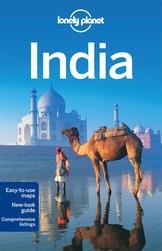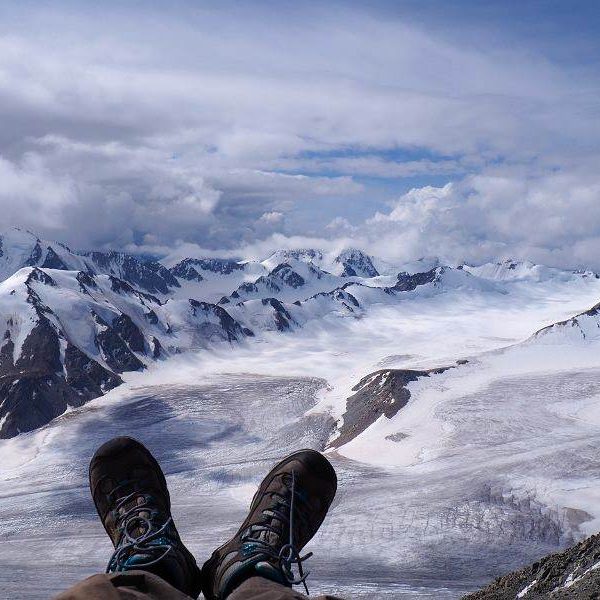The rugged and remote far reaches of western Mongolia are a series of wild landscapes capped by glacier-wrapped mountains, divided by green river valleys and shadowed by soaring peaks. This area is home to the famous Kazakh eagle hunters and has some of the best preserved petroglyphs in the country.
 Otherworldly trekking in western Mongolia © Olivia Pozzan / Lonely Planet
Otherworldly trekking in western Mongolia © Olivia Pozzan / Lonely Planet
But it is the majestic Altai Mountains that dominate this isolated corner of Mongolia. Straddling the borders with Russia and China, the Tavan Bogd is a cluster of Mongolia’s soaring peaks and a draw for climbers, trekkers and horse riders. It culminates in the dramatic 4374m Khüiten Peak, the highest point in the country.
On the road: dramatic landscapes
The western frontier town of Ölgii is little more than a stepping stone to the area’s real attraction – the landscape fringed by distant snow-capped mountains. The vast steppes and great distances in Mongolia make road trips mandatory. Bumping over rutted dirt trails across open plains and ploughing through mud-soaked river valleys is part of the adventure leading to Tavan Bogd. Driving a Furgon, a Russian ex-military jeep, is a popular choice especially when grunt overrides grace.
 Road-tripping in western Mongolia is a beautiful but bumpy affair © Olivia Pozzan / Lonely Planet
Road-tripping in western Mongolia is a beautiful but bumpy affair © Olivia Pozzan / Lonely Planet
The road from Ölgii passes through small villages with brightly coloured rooftops, past wandering camels and grazing livestock, and across miles of pristine wilderness. Scattered across the landscape are ‘deer stones’, upright stone slabs engraved with flying deer or other stylistic symbols. These Bronze Age megaliths are believed to mark ritual or burial sites.
Tavan Bogd
In the Altai Tavan Bogd National Park, glaciers carve rivers of frozen ice between the snow-topped mountains of the Tavan Bogd. These ‘Five Saints’ include Bürged, Malchin, Ölgii and Nairamdal Uul mountains, as well as Mongolia’s highest peak, Khüiten Uul.
 Trekking Tavan Bogd on horseback © Olivia Pozzan / Lonely Planet
Trekking Tavan Bogd on horseback © Olivia Pozzan / Lonely Planet
The scenery in this remote area is stunning. Clear rivers fed by ice-melt tumble down the valleys, a rainbow assortment of wildflowers carpet grassy meadows and white peaks dominate the skyline. Horses and camels can be hired from local Tuvan and Kazakh nomads at the trailhead at the end of the road in the Tsagaan Gol valley. Camels in the snow might seem strange but they are valued as cargo carriers, transporting camping equipment and gear on horse-riding tours.
 Potanii Glacier: worth every aching muscle © Olivia Pozzan / Lonely Planet
Potanii Glacier: worth every aching muscle © Olivia Pozzan / Lonely Planet
The 16km trail to the base camp is a pleasant hike (or ride), climbing gradually through alpine meadows to the crystalline Potanii Glacier. It’s possible to hike the length of the 12km glacier but peak-baggers will want to summit one of the Saints. Khüiten Uul is a technical climb requiring ice axes and crampons but Malchin Peak (4050m) is a straightforward six hour uphill trek. Malchin’s ridge line straddles the Russian border and the summit views are worth every aching muscle and gasping breath. This land of snow and ice is home to the elusive snow leopard and the legendary Mongolia Almas, believed to be a cousin to the yeti. But don’t count on seeing either the wild cat or the wild man.
Rock art and wild ibex
In the shadow of the Tavan Bogd massif are some of the most complex and exquisite petroglyphs to be found in Central Asia. In Tsagaan Saal and in Tsagaan Gol valley, rock art dating from the Neolithic and Bronze Ages give an insight into the life of ancient days. The images include ibex with long curved horns, deer with chandelier antlers, mounted bowmen, camels drawing wagons, snow leopards and rudimentary ger tents. The sacred mountain of Sheveed Uul in the Tsagaan Gol valley holds a storybook of images extending for 15km around its flanks. As well as ancient rock art, local knowledge credits Sheveed Uul as home to roughly 400 wild ibex.
 Western Mongolian storybook: the petroglyphs at Tsagaan Gol © Olivia Pozzan / Lonely Planet
Western Mongolian storybook: the petroglyphs at Tsagaan Gol © Olivia Pozzan / Lonely Planet
A number of endangered mammals live in the Altai Mountains including the snow leopard, wolf and argali sheep – a mountain sheep with impressive corkscrew horns. One mammal that thrives in these mountains is the delightful marmot. If they aren’t standing ‘lookout’, their chubby bottoms can be seen bouncing across the fields and disappearing into a burrow.
Kazakh culture
It’s not only the landscape of western Mongolia that distinguishes it from the rest of the country. Ninety percent of the population here are ethnic Kazakhs. In centuries past, when the first Kazakh nomads migrated to the eastern side of the Altai Mountains to graze their sheep on summer pastures, they didn’t realise their descendants would populate the Bayan-Ölgii province of western Mongolia. After the Mongolian Revolution in 1921, a permanent border was set up and an enclave of Kazakh culture remained.
 Eagle hunting is still an important custom in the Kazakh communities of western Mongolia © Olivia Pozzan / Lonely Planet
Eagle hunting is still an important custom in the Kazakh communities of western Mongolia © Olivia Pozzan / Lonely Planet
Kazakh is spoken here and the ancient Kazakh tradition of eagle hunting is revered. For over 2000 years, central Asian nomads have caught and trained eagles to catch prey. The golden eagle is a magnificent bird – a regal and powerful ruler of the skies. Hunters catch young birds, preferring the bigger, stronger females. After five to ten years, the eagles are released back into the wild to live free once again.
 Room with a view: a ger on the edge of the world © Olivia Pozzan / Lonely Planet
Room with a view: a ger on the edge of the world © Olivia Pozzan / Lonely Planet
Whether Mongolian or Kazakh, hospitality prevails in this part of the world. Nomads will often invite you into their gers, which are basically large round tent-like structures made from felt and canvas. Kazakh-style gers are typically larger than Mongolian gers, and furnished with richly decorated carpets and wall hangings. Expect offerings of yak tea, fried bread, sour cheese and fermented mare’s milk. You’ll then wash it all down with home-made vodka, a potent but surprisingly smooth brew.
Make it happen
 Not just desert animals: camels carry cargo in alpine conditions © Olivia Pozzan / Lonely Planet
Not just desert animals: camels carry cargo in alpine conditions © Olivia Pozzan / Lonely Planet
With a bit of time and patience, independent travellers can organise jeep hire and supplies from Ölgii. If time is tight, organised tours are your best option.RAW Wildlife Encounters (rawildlife.com.au) is a globally recognised and reliable company promoting country owned travel programs with a focus on sustainable travel and wildlife experiences. They offer customised tours in Mongolia, as well as set travel packages.


